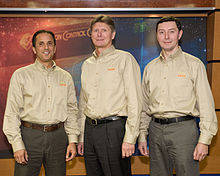
Back Sojuz TMA-04M Czech Sojus TMA-04M German Soyuz TMA-04M Spanish سایوز تیامای-۴ام Persian Sojuz TMA-04M Finnish Soyouz TMA-04M French Soiuz TMA-04M Galician סויוז TMA-04M HE Szojuz TMA–04M Hungarian Sojuz TMA-04M Italian
 Soyuz TMA-04M departs the ISS | |
| Operator | Roscosmos |
|---|---|
| COSPAR ID | 2012-022A |
| SATCAT no. | 38291 |
| Mission duration | 4 months, 2 days |
| Orbits completed | ~1,945[1] |
| Spacecraft properties | |
| Spacecraft type | Soyuz-TMA 11F747 |
| Manufacturer | Energia |
| Crew | |
| Crew size | 3 |
| Members | Gennady Padalka Sergei Revin Joseph M. Acaba |
| Callsign | Altair |
| Start of mission | |
| Launch date | 15 May 2012, 03:01:23 UTC[2][3] |
| Rocket | Soyuz-FG |
| Launch site | Baikonur 1/5 |
| End of mission | |
| Landing date | 17 September 2012, 02:53 UTC[4] |
| Orbital parameters | |
| Reference system | Geocentric |
| Regime | Low Earth |
| Perigee altitude | 410 kilometres (250 mi) |
| Apogee altitude | 433 kilometres (269 mi) |
| Inclination | 51.64 degrees |
| Period | 92.86 minutes |
| Epoch | 17 September 2012, 01:22:43 UTC[1] |
| Docking with ISS | |
| Docking port | Poisk zenith |
| Docking date | 17 May 2012, 04:36 UTC |
| Undocking date | 16 September 2012, 23:09 UTC |
| Time docked | 4 months |
 (l-r) Acaba, Padalka and Revin Soyuz programme (Crewed missions) | |
Soyuz TMA-04M was a spaceflight to Low Earth orbit that transported three members of the Expedition 31 crew to the International Space Station (ISS), which was launched on 15 May 2012 and landed on 17 September 2012.[3] TMA-04M was the Soyuz spacecraft's 113th flight since its initial launch in 1967, and the fourth launch of the improved Soyuz TMA-M series (first launched 7 October 2010). As per the mission plan, the spacecraft remained docked to the space station to serve as an emergency escape vehicle during Expedition 31.
The mission was successfully launched to the International Space Station from the Baikonur Cosmodrome in Kazakhstan on Tuesday, 15 May 2012, at 3:01:23 UTC (9:01:23 local time).[5] The Soyuz docked successfully with the ISS on 17 May at 4:36 UTC.[6] The spacecraft carried to the ISS a three-person crew (Gennady Padalka, Russia; Sergei Revin, Russia; Joseph Acaba, United States).[5] The mission landed successfully in Kazakhstan on 17 September 2012, at 2:53 UTC.[4]
- ^ a b Peat, Chris (17 September 2012). "SOYUZ-TMA 4M - Orbit". Heavens Above. Retrieved 31 October 2013.
- ^ William Harwood (February 12, 2012). "Russia Orders Soyuz Delays In Wake Of Test Mishap". SpaceflightNow.com. Retrieved February 12, 2012.
- ^ a b "Three New Crew Members En Route to Station". Latest News. NASA. Retrieved May 14, 2012.
- ^ a b "Expedition 32 Lands Safely in Kazakhstan". National Aeronautics and Space Administration. Retrieved 17 September 2012.
- ^ a b Harwood, William (May 18, 2012). "Latest manned space launch safely takes flight to orbit". Spaceflight Now. Retrieved May 18, 2012.
- ^ Harwood, William (May 17, 2012). "Three-man crew docks at International Space Station". Spaceflight Now. Retrieved May 17, 2012.